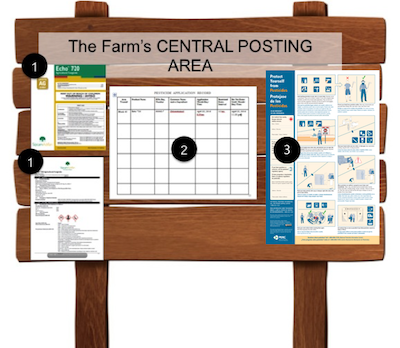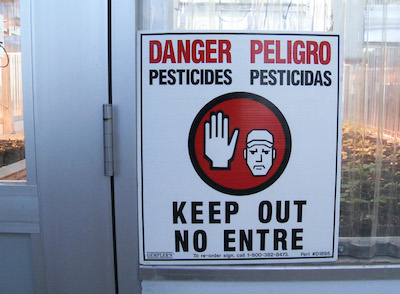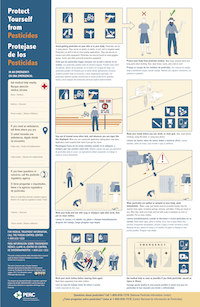Hazard communication is an important way to protect the health of agricultural workers and pesticide handlers. Agricultural employers must ensure that employees receive protections in the workplace. Hired commercial pesticide handler employers also play an important role.
Hazard communication is the practice of telling people about dangers they might encounter. On agricultural establishments, hazard communication for workers and handlers must include the following information:
- Location and description of areas where pesticides are applied
- Specific information about the pesticides, including their active ingredients, EPA registration numbers, pesticide labels, and Safety Data Sheets (SDS)
- How to understand posted warnings signs and follow directions
- Sources of pesticide exposure (water, soil, plants, equipment, etc.)
- Different ways pesticides can enter the body (swallowing, breathing, skin and eyes)
- Signs and symptoms of pesticide poisoning
- Entry-restrictions related to a pesticide application
- Methods to reduce pesticide exposure and prevent take-home exposures
- Emergency first aid for pesticide exposures
- Emergency decontamination procedures
- Instructions to seek medical attention if poisoned, injured or made ill by pesticides
- Location and phone number for a nearby medical facility that can provide emergency medical treatment
Hazard communication can come in different forms on an agricultural establishment. The revised WPS has requirements for displaying safety information and posting warning signs around areas of application. It also requires verbal warnings in some cases. The goal is to make sure workers and handlers get accurate information about the pesticides they might encounter in their work.
A Central Location for Pesticide Information
Central displays must include pesticide safety, application, and hazard information. They must be displayed where workers and handlers are likely to congregate. They should be able to see and read the information easily.

Required hazard information includes:
- Safety data sheets for pesticides applied in the last 30 days
- You may also post instructions about where workers can locate the safety data sheets, if they are housed elsewhere.
- Pesticide application records for the last 30 days
- Pesticide name, EPA Reg. No., and active ingredient(s)
- Location and description of treated areas
- The crop or site that was treated
- Application date(s), and the times the application started and ended
- The length of the restricted-entry interval (REI) in treated areas
- Pesticide Safety Poster (or equivalent)
- This poster includes contact information for state/tribal pesticide regulatory authorities and the nearest medical facility
- It includes information about where pesticides may be encountered, routine decontamination methods, and emergency procedures
- You can buy or print copies of one such poster here.
Decontamination Sites
A pesticide safety poster (or equivalent) is required to be displayed at all permanent decontamination sites, and wherever decontamination supplies are provided for 11 or more employees. It reminds people where pesticide residues are found, becoming a familiar prompt for routine hand-washing.
Smaller posters (11X17) are available from PERC.
Establishment-Specific Information
Agricultural employers must provide this information to workers and handlers when they arrive on the agricultural establishment, before they perform work in treated areas.
- Location of pesticide safety, application and hazard information (central location)
- Location of decontamination supplies (soap, water, and single-use towels)

Posted Warning Signs or Verbal Warnings
Warning signs must be used to notify workers of pesticide applications with an REI greater than 48 hours. Agricultural employers can also choose to use them instead of verbal warnings for products with an REI of 48 hours or less. Warning signs must meet several requirements:
- Size requirements: Standard signs must be at least 14" x 16" with one inch letters
- Posted prior to the scheduled application, but not more than 24 hours before.
- Remain posted during the application and any restricted-entry interval
- Removed or covered within 3 days of the application or REI ending, whichever is later
Learn more about posting warning signs.
Annual Training for Workers and Handlers
Agricultural workers and pesticide handlers must receive training before they begin work and every 12 months. That training includes information about pesticide residue, the potential health effects of pesticide exposure, and how to avoid bringing pesticide residues home. Trainers must be qualified.
What makes a WPS trainer "qualified?" They must meet one of these criteria:
- Hold a current pesticide applicator license
- Complete an EPA-approved Train-the-Trainer (TTT) course
- Become designated as a trainer by the state's lead agency for regulating pesticides
Requirements related to WPS training delivery for workers and handlers:
- Trainers must remain present and answer questions
- Training materials must be EPA-approved
- Training must be delivered in a manner that trainees can understand
- Training must be delivered in a place that's conducive to learning, and relatively free of distractions
Information Exchange When 3rd Party Labor is Used
When you work with labor contractors and/or custom applicators (commercial pesticide handler employers), it's important to exchange information about pesticides in treated areas, equipment, and other locations.
Labor Contractor
Before workers begin their work on the agricultural establishment, the owner/operator must ensure the workers receive all of the protections required under the WPS.
- Ensure that workers have received WPS training in the last 12 months; keep records on file for two years.
- Ensure that workers know where to find decontamination supplies and the central posting location on the establishment .
- Ensure that workers are supplied with decontamination supplies within 1/4 mile of where they will be working, or the nearest vehicular access.
- Ensure that workers will have transportation to a medical facility in case of emergency.
- If contracted workers will handle pesticides, there are more requirements.
Commercial Pesticide Handler Employer (Custom Applicator)
Before any application, commercial pesticide handler employers (CPHE) must make sure the owner/operator of an agricultural establishment is aware of:
- Location and description of area to be treated,
- Date of application, estimated start time, and estimated end time of the application,
- Product name, EPA Reg. No., active ingredient(s) and restricted-entry interval (REI),
- Whether the product label requires posted warning signs in addition to verbal warnings, and
- All other safety requirements on labeling for workers or other people.
Owners/operators of agricultural establishments must make sure any CPHE they hire is aware of:
- Specific location and description of any treated areas where an REI is in effect that the commercial handler may be in or walk within 1/4 mile of, and
- Restrictions on entering those areas.
The CPHE must pass this information along to the handler doing the work.
3rd Party Equipment Service
Before allowing someone to clean, repair, or adjust any equipment that may have pesticide residues, agricultural employers must notify them of the following:
- Equipment may be contaminated with pesticides,
- Potential harmful effects of exposure to pesticides,
- Procedures for handling equipment and limiting exposure to pesticide residues, and
- Decontamination procedures for removing residues and preventing take-home exposures.
These elements are included in annual handler training events, but the 3rd party mechanic who comes on site to service a ground rig may not have received handler training.
3rd Party Laundry Service
Before allowing someone to clean contaminated PPE, the employer must notify them of the following:
- That such equipment may be contaminated with pesticides and there are potentially harmful effects from exposure to pesticides.
- The correct way(s) to clean PPE and how to protect themselves when handling such equipment.
- Proper decontamination procedures that should be followed after handling contaminated PPE.



